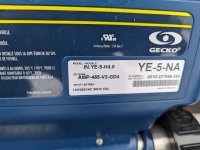Hey,
I've had our hot tub since November and have a pretty good handle on things but just added an ozonator. I understand chlorine can now be 0.5 ppm but how do I actually know if my ozonator is actually doing anything? I installed it and do know it powers on, is plumbed in correctly, flows when the jets are on and adds ozone right before entering the tub via a jet. It only runs during filter mode and that jet is on that pump as well. I'm familiar with ozone smell from other air purifiers but I don't smell any of that. I've had it installed for a week or so. Sure, I can check my chlorine and make sure it's lower now but if the ozonator isn't working or working well then I just get unsafe water without knowing. Someone said you know because small air bubbles come out of the jet. Well, the ozone only runs when the jet is on so that's going to happen to some extent regardless.
Do I not smell ozone because I didn't change the water because it's currently -30 outside... Since the water is a couple months old I can see needing time to catch up, or should I notice something by now? There is a small change in smell but I wouldn't say ozone like our air ones are. Before plumbing in I did turn it on and did smell some ozone so should be working.
I should add that I currently have the filters/ozone running from midnight for 5 hours. Then noon for 3 hours. Maybe someone has suggestions on that or if that amount of time is ok.
Thanks for the help!
Kevin
I've had our hot tub since November and have a pretty good handle on things but just added an ozonator. I understand chlorine can now be 0.5 ppm but how do I actually know if my ozonator is actually doing anything? I installed it and do know it powers on, is plumbed in correctly, flows when the jets are on and adds ozone right before entering the tub via a jet. It only runs during filter mode and that jet is on that pump as well. I'm familiar with ozone smell from other air purifiers but I don't smell any of that. I've had it installed for a week or so. Sure, I can check my chlorine and make sure it's lower now but if the ozonator isn't working or working well then I just get unsafe water without knowing. Someone said you know because small air bubbles come out of the jet. Well, the ozone only runs when the jet is on so that's going to happen to some extent regardless.
Do I not smell ozone because I didn't change the water because it's currently -30 outside... Since the water is a couple months old I can see needing time to catch up, or should I notice something by now? There is a small change in smell but I wouldn't say ozone like our air ones are. Before plumbing in I did turn it on and did smell some ozone so should be working.
I should add that I currently have the filters/ozone running from midnight for 5 hours. Then noon for 3 hours. Maybe someone has suggestions on that or if that amount of time is ok.
Thanks for the help!
Kevin


